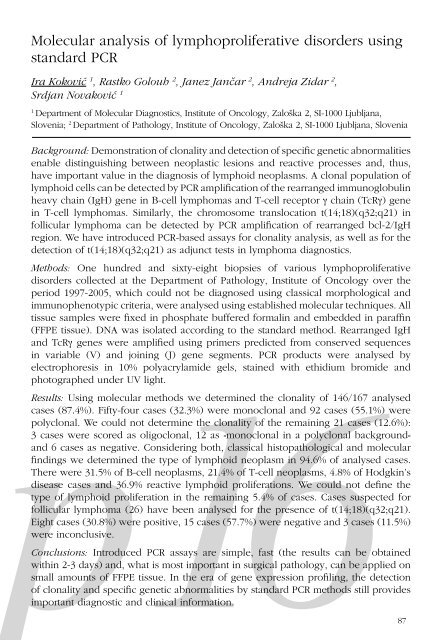You also want an ePaper? Increase the reach of your titles
YUMPU automatically turns print PDFs into web optimized ePapers that Google loves.
Molecular analysis of lymphoproliferative disorders using<br />
standard PCR<br />
Ira Kokovi} 1 , Rastko Golouh 2 , Janez Jan~ar 2 , Andreja Zidar 2 ,<br />
Srdjan Novakovi} 1<br />
1<br />
Department of Molecular Diagnostics, Institute of Oncology, Zalo{ka 2, SI-1000 Ljubljana,<br />
Slovenia; 2 Department of Pathology, Institute of Oncology, Zalo{ka 2, SI-1000 Ljubljana, Slovenia<br />
Background: Demonstration of clonality and detection of specific genetic abnormalities<br />
enable distinguishing between neoplastic lesions and reactive processes and, thus,<br />
have important value in the diagnosis of lymphoid neoplasms. A clonal population of<br />
lymphoid cells can be detected by PCR amplification of the rearranged immunoglobulin<br />
heavy chain (IgH) gene in B-cell lymphomas and T-cell receptor γ chain (TcRγ) gene<br />
in T-cell lymphomas. Similarly, the chromosome translocation t(14;18)(q32;q21) in<br />
follicular lymphoma can be detected by PCR amplification of rearranged bcl-2/IgH<br />
region. We have introduced PCR-based assays for clonality analysis, as well as for the<br />
detection of t(14;18)(q32;q21) as adjunct tests in lymphoma diagnostics.<br />
Methods: One hundred and sixty-eight biopsies of various lymphoproliferative<br />
disorders collected at the Department of Pathology, Institute of Oncology over the<br />
period 1997-2005, which could not be diagnosed using classical morphological and<br />
immunophenotypic criteria, were analysed using established molecular techniques. All<br />
tissue samples were fixed in phosphate buffered formalin and embedded in paraffin<br />
(FFPE tissue). DNA was isolated according to the standard method. Rearranged IgH<br />
and TcRγ genes were amplified using primers predicted from conserved sequences<br />
in variable (V) and joining (J) gene segments. PCR products were analysed by<br />
electrophoresis in 10% polyacrylamide gels, stained with ethidium bromide and<br />
photographed under UV light.<br />
Results: Using molecular methods we determined the clonality of 146/167 analysed<br />
cases (87.4%). Fifty-four cases (32.3%) were monoclonal and 92 cases (55.1%) were<br />
polyclonal. We could not determine the clonality of the remaining 21 cases (12.6%):<br />
3 cases were scored as oligoclonal, 12 as »monoclonal in a polyclonal background«<br />
and 6 cases as negative. Considering both, classical histopathological and molecular<br />
findings we determined the type of lymphoid neoplasm in 94.6% of analysed cases.<br />
There were 31.5% of B-cell neoplasms, 21.4% of T-cell neoplasms, 4.8% of Hodgkin’s<br />
disease cases and 36.9% reactive lymphoid proliferations. We could not define the<br />
type of lymphoid proliferation in the remaining 5.4% of cases. Cases suspected for<br />
follicular lymphoma (26) have been analysed for the presence of t(14;18)(q32;q21).<br />
Eight cases (30.8%) were positive, 15 cases (57.7%) were negative and 3 cases (11.5%)<br />
were inconclusive.<br />
Conclusions: Introduced PCR assays are simple, fast (the results can be obtained<br />
within 2-3 days) and, what is most important in surgical pathology, can be applied on<br />
small amounts of FFPE tissue. In the era of gene expression profiling, the detection<br />
of clonality and specific genetic abnormalities by standard PCR methods still provides<br />
important diagnostic and clinical information.<br />
p1687
















